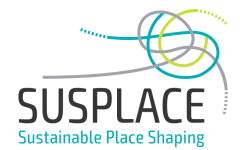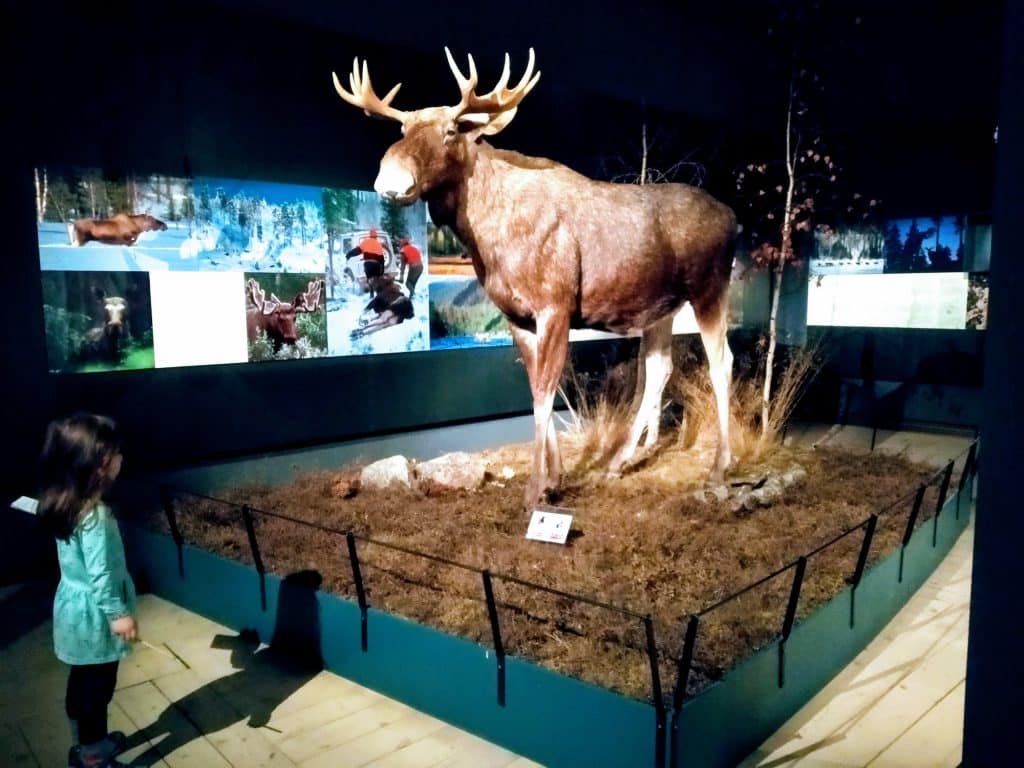
By Sara Grenni & Angela Moriggi
This past November, for the first time since our arrival to Finland, we brought some SUSPLACE vibes to Lapland!
It took a pleasant 12 hours night train ride to get to Rovaniemi, where the annual colloquium of the Finnish Society for Environmental Social Sciences (YHYS) took place from November 21st to November 23rd, hosted by the University of Lapland.
The theme of this year’s edition was “Naturecultures”, on the back of current discourses challenging the traditional notion of nature/culture divide and centred on one of the most critical questions of our times: how can we comprehend the co-existence of nature and society?
The programme included a rich variety of thematic sessions, but the one that immediately caught our attention (at the time of the call for abstract) was “Investigating togetherness in a more-than-human society: More-than-human methodologies”. It felt just like the perfect avenue to share the experience and reflections harvested over the last year as a result of the co-creation work that led to the publication of the SUSPLACE Toolkit (see a previous blog on this here).
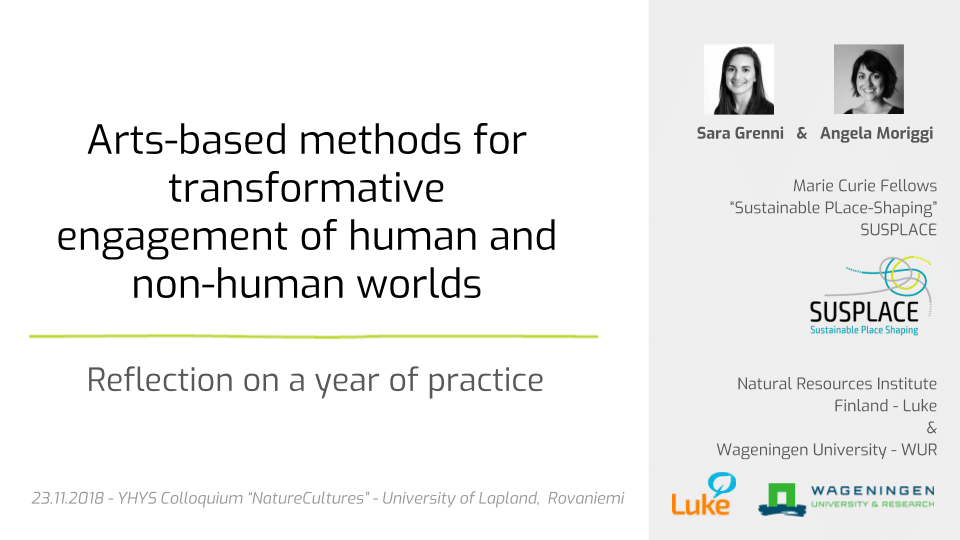
To get a feeling of the fresh research brewing in the field of environmental humanities, the two of us participated to the early career researcher meeting, convened by Mikko Äijälä and Tarja Salmela, on November 21st. The gathering was modeled on the “Hyde Park” format – in which a group of five 5-minute speed-talks was followed by a 15-minute discussion round.
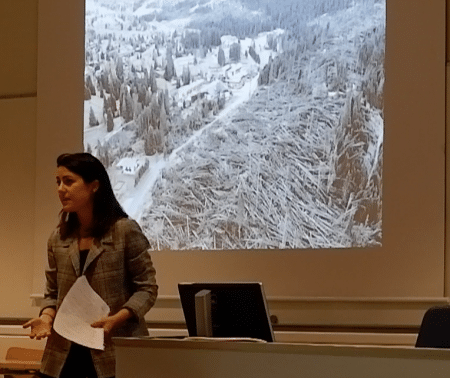
Angela gave a short speech on the potential of response-ability in shaping our caring actions, inspired by the recent floods that hit Northern Italy, destroying 14 million trees. We met many familiar faces from the academic circles in Helsinki, and got to know new PhD fellows! The informal and enabling atmosphere and the rich buffet of snacks and drinks, powered us through the almost four hours (!) of presentations and discussion.
The colloquium proper started the next morning; on Day 1, we were welcomed by two fascinating keynote speeches. First, Dr. Laura Watts from the University of Edinburgh delivered a powerful lecture (fully available here) presenting her work on energy futures in the Orkney Islands, Scotland. In her book on this project, titled Energy at the End of the World: An Orkney Islands Saga, Prof. Watts draws from the traditional sagas and other storytelling techniques to communicate the technological innovations taking place on these remote islands; fittingly she also structured her talk as a tale in three acts, harnessing the power of narration to take us on a journey of exploration of possible futures.
The second Keynote was given by Prof. Rauna Kuokkanen from the University of Lapland, a Sámi advocate and founder of the Sámi Youth Organisation in Finland. Her talk brought an indigenous perspective to the Natureculture debate, highlighting how indigenous worldviews and philosophy – long diminished and ignored – are now entering the mainstream, often via appropriation by the environmental discourse. As empirical material, she presented the case of Ellos Deatnu (Northern Sami for ‘long live the Tana river’) a Sámi activist group that started a protest over fishing rights in the Tana River region, on the border between Norway and Finland.
The rest of the day was busy with talks in the various parallel sessions, and culminated with the conference dinner at the Koti-Café, where we enjoyed a sumptuous vegan meal spiced with stimulating conversation with fellow conference goers.
Day 2 started full-on with the second round of parallel sessions, where we finally delivered our presentation, titled “Arts-Based Methods for Transformative Engagement of human and more-than-human worlds: Reflections on a year of practice”.
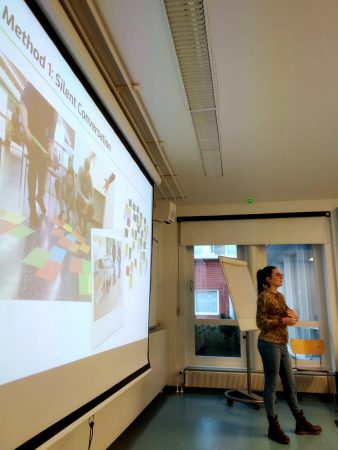
It was a good opportunity to reflect on the co-creation process that engaged six SUSPLACE researchers, to design the workshop that was first piloted at Transformations 2017 Dundee, and that later culminated in the publication of the Arts-based toolkit in February 2018. In our presentation, we shared the ways in which art can be used to increase empathy towards the more-than-human world and shift mindset towards more regenerative paradigms. We also reflected on the feedback received from the workshop participants, highlighting key success factors and possible room for future improvement. Our work was received enthusiastically, and we certainly contributed to spread the “SUSPLACE Gospel” of the numerous possibilities to study relational place-making among a new audience!
The event then came to a close with two final keynotes. First was Dr. Päivö Kinnunen from the University of Oulu, who spoke about “Engineered future – reflections on the role of applied sciences on sustainability”. Holding a PhD in Applied Physics, Dr. Kinnunen presented his work in the field of circular economy, including recent technological advancements in the development of new products from wastes and industrial residues. His focus on geopolymers and sustainable cementitious binders might have been a change of pace for many of the social scientists in the room, but in the end, the keynote left us with a provocation: technology may help us find the answers, but we have to come up with the questions first.
The closing keynote was given by Dr. Phillip Vannini, an ethnographer, filmmaker and author currently researching the cultural dimension of UNESCO World Heritage nature sites. Dr. Vannini started with the question: can we speak of wildness in the Anthropocene? And went on to challenge once again the notion of a nature-culture divide, and the Western idea that has come to portray humans as separate from wilderness. Even our Nature Conservation areas – Dr. Vannini highlighted – are valued for their natural, and not their naturecultural value. In opposition, he offered a relational perspective to understanding wild life, one that is very common in indigenous cultures around the globe.
In an attempt to explore naturecultures further, we carved a couple of hours to visit the beautiful museum Artiktum, displaying – among other, the everyday life and stories of the Arctic, and the grim consequences of the several wars that invested Lapland in the 20th century. Among the pleasant surprises we discovered in the museum, Angela saw a scene of her forthcoming SUSPLACE Children Book’s story, staging a moose and a young girl – coming to life!
In the end, we brought back to Helsinki lots of inspiring thoughts, new connections and open questions.
